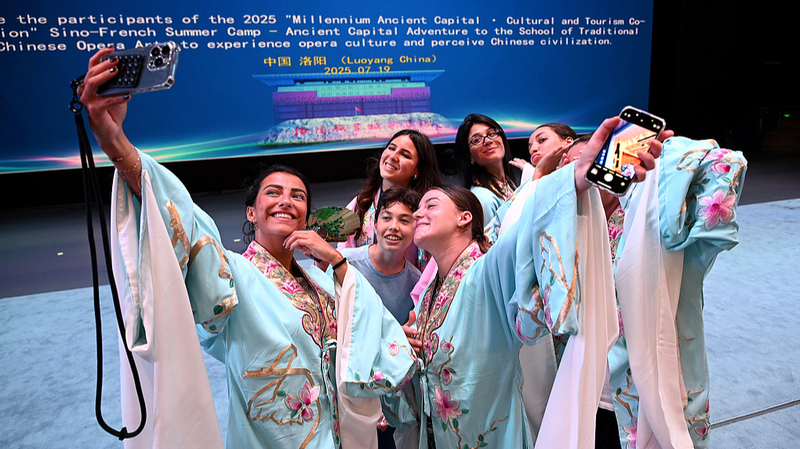In a sunlit courtyard at the China Cultural Center in Paris, locals moved through the slow, flowing motions of Tai Chi under the guidance of Professor Zhou Qingjie from China Foreign Affairs University. More than a workout, the practice embodies traditional Chinese philosophy – an expression of harmony between humans and nature, or "Tian Ren He Yi."
Scenes like this illustrate an evolving and deepening exchange between Chinese and European civilizations, moving from formal settings into the fabric of everyday life.
From Cultural Curiosity to Shared Experience
Over the past five decades, mutual learning and shared development have been central to China–EU ties. Cultural and people-to-people exchanges have emerged as an enduring source of vitality.
At the LANTING – Chinese Calligraphy Culture Salon in Berlin, German visitors explored ancient art through brushwork and ink, gathering not only to admire traditional works but also to try writing Chinese characters themselves.
Cultural interaction extends beyond the arts. In May, three golden snub-nosed monkeys from the Chinese mainland's Qinling Mountains began a 10-year stay at Pairi Daiza Zoo in Belgium. For Eric Domb, the zoo’s founder and chairman, their arrival symbolizes more than zoological cooperation. "They are like characters from a modern-day Journey to the West," Domb said, referring to the classic novel by Wu Cheng’en. He called these monkeys "ambassadors" of China–EU friendship, highlighting shared values in biodiversity and wildlife conservation.
Chinese cultural exports are also resonating with European audiences. The animated blockbuster "Nezha 2" premiered this year in Greece, the UK, Germany, Belgium, and Spain to strong reviews and solid ticket sales. Meanwhile, dragon boat races across multiple European countries during the Dragon Boat Festival drew large crowds.
Tourism: A Two-Way Journey of Discovery
This cultural momentum is mirrored in tourism. The 2025 Budapest China Tourism and Culture Week kicked off in May in Hungary’s capital, where officials praised growing ties. "China has become one of the most important source markets for tourists to Hungary," said Szabolcs Szilagyi from the Hungarian Tourism Agency.
Budapest now has direct flight routes to seven cities in China, positioning it as a key hub between Central and Eastern Europe and the Chinese mainland.
Switzerland, marking the 75th anniversary of diplomatic ties with the Chinese mainland in 2025, is hosting the Switzerland–China Year of Culture and Tourism. Swiss Ambassador to China Jürg Burri said his team plans diverse activities across several cities and hopes to welcome more Chinese travelers through streamlined visas and eco-friendly initiatives.
In Spain’s Valencia region, tourism officials are targeting Chinese visitors with a presence on major Chinese social platforms. "We’ve also established sister city ties with Guangzhou, Chengdu, and Xi’an to deepen people-to-people relations," said Miguel Angel Perez Alba from Visit Valencia.
According to Travel And Tour World, tourism between China and Europe is recovering robustly. In 2024 alone, over 97 million trips were made both ways, thanks in part to China's unilateral visa-free policy for 24 EU members, laying a strong foundation for mutual learning.
Youth Connections Bring Fresh Energy
Youth exchanges are injecting new vitality into China–EU relations. Students from Ireland, France, Germany, and Hungary have visited campuses in the Chinese mainland, engaging in cultural experiences and forging lasting friendships. "Our students feel the warmth and friendship here," said Patrick Egan from Ireland’s Rockwell College, which plans to send 20 students annually.
In 2016, China signed agreements on mutual recognition of higher education degrees with 19 EU members, including France, Germany, and Italy, paving the way for balanced, two-way student mobility.
Meanwhile, Chinese language education is booming across Europe. France hosts over 60 international Mandarin classes in public schools, and Spain has more than 60,000 students learning the language, making it one of the EU’s most enthusiastic adopters.
Together, these dynamic exchanges – from cultural festivals to student mobility – are weaving people-to-people connections into the very fabric of China–EU relations, promising deeper understanding and cooperation in the years ahead.
Reference(s):
cgtn.com
